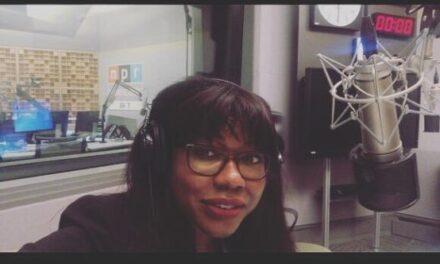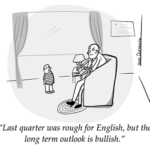Seven trends that will make you feel excited and optimistic about education journalism.
For all the many challenges, there are some positive developments in education journalism lately. It’s important not to lose sight of them, especially in difficult times.
Here are seven trends and developments to celebrate —things that make me happy and optimistic about media coverage of education:
1: Expansion? Yes!

The Boston Globe’s new Spotlight initiative, called The Great Divide, just launched.
The news that the Boston Globe’s prestigious investigative “Spotlight” team would expand its focus on education was probably the best education journalism news of the past six months. The Globe’s recent Valedictorians Project examining the disappointing experiences of Boston Public Schools valedictorians after high school graduation was a vivid example of what is possible. Sarah Carr will edit the team. She is universally respected, EWA’s Emily Richmond notes. “I can’t wait to see who she hires, and I can’t wait to see what they do,” Richmond said in a recent phone interview.
For more about The Great Divide, the new Boston Globe initiative launched Friday, read here. From the looks of it, Meghan Irons, Malcolm Gay, and Carr will be the lead team members. USA Today has also grown its national education team, with reporter Erin Richards on K-12, Chris Quintana on higher education, and national education editor Chrissie Thompson, along with a more robust use of talented Gannett education reporters from around the country.
For more on what made the Valedictorians Project so good, read an interview we did with Boston Globe reporters Malcolm Gay and Meghan Irons here. Both the Globe and USA Today’s efforts are foundation-supported, as is The Grade.
2: New faces, more job openings.
As Best of the Week newsletter readers know, new names and faces keep coming into education journalism, and newly open spots are being advertised rather than left empty or closed out. Maybe that’s why EWA is for the first time expanding its New to the Beat training session into a standalone two-day event in October. A few examples: Annie Ma has replaced Ann Doss Helms at the Charlotte Observer. Nina Agrawal has just started covering education at the LA Times. (Speaking of which, I’m also really excited about the recent arrivals of education editors Stephanie Chavez at the LA Times and Tony Marcano at KPCC LA.) Chalkbeat Detroit’s Lori Higgins announced that she’s taking on the new role of Detroit bureau chief. And The Atlantic is looking for a new education editor.
Newsroom comings and goings are featured each week in the Best of the Week newsletter. You can subscribe or read the archive here.
3: Books are back!

One of several new education books out recently.
For a couple of years, it seemed as if nobody was writing education books anymore. But some interesting new books have emerged from publishers lately: Robert Pondiscio on Success Academy, Paul Tough on college and inequality, and Natalie Wexler on teaching content vs. reading skills.
There are more education books coming down the pike: Nikole Hannah-Jones’ book on segregation and integration is still in the works, though Hannah-Jones tells me a 2020 publication date is not yet set. There’s also “Accepted,” a forthcoming book about the Varsity Blues scandal from Wall Street Journal reporters Melissa Korn and Jennifer Levitz. Coming in 2021, Jo Napolitano has a book about immigrant children from Syria and other countries who relocate to suburban and rural America. And Cara Fitzpatrick, who reported the Pulitzer Prize-winning Failure Factories series a few years back, has a new book about the history of school choice in the works for 2021.
Read Pondiscio’s take on the strengths and challenges facing education journalism here.
4: Complicating the narrative(s).
Whether it’s Laura Meckler’s recent school segregation piece or Robert Pondiscio’s Success Academy book, more stories aim for complexity rather than simplification. This is certainly a good thing. Journalism that depicts the nuances of education efforts is essential for an informed public and a balanced understanding of events. My favorite recent example of an appropriately complicated narrative is Tara Garcia Mathewson’s story about how a pair of idealists in Massachusetts won a $10 million competition to reinvent high school in ways that would engage more students but found themselves blocked at the last minute from opening the school. Real life is complicated; readers know that and can handle it.
Read an interview with Amanda Ripley about how to complicate the narrative in education journalism here.
5: Increasing focus on opportunity hoarding in education.
Education coverage isn’t just about the achievement gap or acceptance rates at Harvard anymore. And Varsity Blues was just the tip of the iceberg. Since that scandal broke, ProPublica has unearthed evidence of parents emancipating their kids — giving up legal custody — in order to win scholarship dollars. The New York Times and others have described how wealthy parents pay for tutoring so their 4-year-olds can score well on the city’s gifted and talented exam or get their children diagnosed as having special education needs to have more time taking tests. Vox and others have detailed how wealthy and mostly white enclaves keep trying to secede from larger, more diverse school districts. In a recent piece, The Washington Post’s Laura Meckler included interviews with parents and educators whose decisions contributed to school segregation. It’s squirmy stuff to read, but important to depict. Education reporters and editors know that it’s time to focus more attention on those who benefit.
6: A return to coverage of classroom instruction.

WHYY story about parents investigating classroom instruction in response to their children’s struggles.
For a few years, education coverage shied away from classroom instruction. But there’s been a small but clear trend toward returning to the classroom for stories, including obvious examples like Emily Hanford’s big 2018 and 2019 documentaries and smaller ones like WHYY Philadelphia’s story about suburban moms-turned-activists pressuring schools to do a better job of teaching kids to read. There’s still a long way to go, but it’s important progress. School lunch shaming and immigrant education stories are important and intriguing, but more education reporters and editors seem to recognize that classroom learning is education’s core function.
Read more about why reporters shy away from writing about reading instruction in this Emily Hanford interview. Read Wexler’s essay on why education reporters don’t pay much attention to the lack of reading content instruction here.
7: Paired K-12 reporters paying off
The two-reporter setup isn’t as common as it once was way back when education teams were much bigger than they are now, but in the places where the arrangement remains it seems that having more than one reporter covering the same beat that makes everything a bit better.
It’s not just that they can put out more stories. Each reporter’s skills and interests complement the other’s. Or at least that’s what seems to be happening. “There’s definitely a synergy there,” EWA’s Richmond said. Having another person covering the same beat gives reporters “someone to bounce ideas off of and to share the day-to-day burden,” and more time to think and innovate.
Take Moriah Balingit and Laura Meckler at the Washington Post. Balingit has had a great year or so, focusing on big-picture stories and making our spring favorites roundup. Meckler just dropped a big piece on school integration that provides an alternate narrative to the segregation narrative that is most common these days.
Erica Green and Dana Goldstein at the New York Times don’t work in the same place, but their work seems to complement each other’s, with Goldstein focused on coverage of teachers and education politics and Green focused on systemic injustice and inequality. K-12 reporting duos at the local level who show this kind of synergy include Liz Bowie and Talia Richman at the Baltimore Sun and Dahlia Bazzaz and Neal Morton at the Seattle Times.
What makes the New York Times’ Erica Green so good? Read here. Read more about Balingit’s excellent work in our Spring 2019 favorites roundup.
That’s my list of bright spots. But there are lots of others.
What is making you excited or renewing your optimism about education journalism these days?
Related posts:
Favorite bylines, outlets, & education teams for spring 2019
What makes New York Times education reporter Erica Green so good?
11 amazing education stories from 2018
ABOUT THE AUTHOR

Alexander Russo
Alexander Russo is founder and editor of The Grade, an award-winning effort to help improve media coverage of education issues. He’s also a Spencer Education Journalism Fellowship winner and a book author. You can reach him at @alexanderrusso.
Visit their website at: https://the-grade.org/













